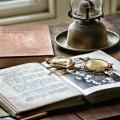This picture comes from the reference collection of photographs in Andover library and is a copy made by Derek Dine in the 1980s of an earlier image.
The reverse is labelled Caldecott House Andover, c.1910, but with no address.
Victorian directories list John Devon Caldecott as a corn and seed merchant whose premises were somewhere in Bridge Street and whose house was at 19 London Street.
House numbering in London Street was changed after the Second World War to allow for an increase in properties, so No 19 became No 43, and although there have been enormous changes, it is easy to locate No 19/43 today, as it is adjacent to the large brick building that was once part of the Andover Saleroom and is now The Rock House.
John Devon Caldecott was born in Torquay (hence the middle name) in 1833 and married Eliza Vernez at Greenwich in 1859.
The couple settled in Barton Stacey where John traded as a maltster and corn merchant.
He supplied the brewing trade over a large area and there are two mentions of him in the London Gazette during the 1860s where he is listed among others as a creditor to brewers who had been declared bankrupt.
By the time of the second one in 1868, the couple and their six-year-old son, John Barton Caldecott (another second Christian name to reflect the place of birth), had moved to Andover.
His Bridge Street premises remain unidentified but they may have been on the site of the recently closed post office as this was certainly a corn yard before 1913.
Local historian Andrew Jackson records Caldecott as a shareholder in the Catherine Wheel coffee house in Bridge Street from 1879 and also for many years the treasurer of the soup and coal fund but there is little else to find.
He continued to live in London Street after retirement and he died in 1905.
Caldecott House still exists but it looks very different from what we see here.
Even if the decorative cast ironwork had survived into the 1930s, most local railings were lost during World War II when there was a demand for scrap metal.
Lately, some new ironwork has replaced it.
The ornate Victorian gas lamp now has an electrical version in roughly the same spot.
Principally however, the entire ground floor frontage, including the impressive stone porch was removed in converting the building to shop premises, sometime in the later 1940s, with the first floor becoming living accommodation for the shop manager, accessed by a new door to the east side.
The shop became a branch of Dick’s, electrical retailers who also specialised in radios, and run by Mr and Mrs Norman Gray.
Dick’s continued until about 1963, when Andover Carpet and Bedding Centre took over for a few years, after which it became a sweet shop, first as Jenifer’s and then, in the early 1970s, Quality Street.
Almost opposite the Savoy, it was a magnet for cinema-going children, as sweets were more expensive in the cinema itself.
In later years, as well as having 1970s extensions to the rear of the east side, the shop frontage was split into two sets of premises, though sadly the successive tenancies have been of short duration.
In the 1990s, the cellar was opened up as a restaurant but that too was soon closed.
Today, it is still empty and looks a sorry state; another empty shop in need of tenants and a facelift.






Comments: Our rules
We want our comments to be a lively and valuable part of our community - a place where readers can debate and engage with the most important local issues. The ability to comment on our stories is a privilege, not a right, however, and that privilege may be withdrawn if it is abused or misused.
Please report any comments that break our rules.
Read the rules here